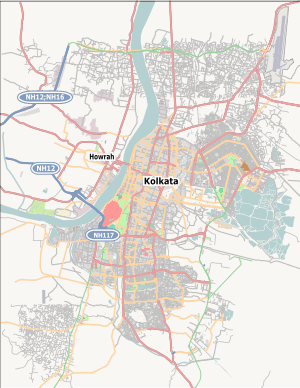Kumortuli
| Kumartuli কুমারটুলি | |
|---|---|
| Neighbourhood in Kolkata (Calcutta) | |
|
Clay images under preparation at Kumartuli | |
 Kumartuli কুমারটুলি Location in Kolkata | |
| Coordinates: 22°36′00″N 88°21′41″E / 22.6000°N 88.3614°ECoordinates: 22°36′00″N 88°21′41″E / 22.6000°N 88.3614°E | |
| Country |
|
| State | West Bengal |
| City | Kolkata |
| Ward |
|
| Metro Station | Shobhabazar-Sutanuti |
| Elevation | 36 ft (11 m) |
| Time zone | IST (UTC+5:30) |
| Area code(s) | +91 33 |
Kumortuli (also spelt Kumartuli, or the archaic spelling Coomartolly) (Bengali: কুমোরটুলি) is a traditionally potters’ quarter in northern Kolkata (previously known as Calcutta), the capital of the east Indian state of West Bengal. The city ios famous as a sculpting hot-spot which not only manufactures clay idols for various festivals but also regularly export them.
History
The British colonisation of Bengal and India started following the victory of the British East India Company in the Battle of Plassey in 1757. The Company decided to build new settlement Fort William at the site of the Gobindapur village. Most of the existing population shifted to Sutanuti. While such neighbourhoods as Jorasanko and Pathuriaghata became the centres of the local rich, there were other areas that were developed simultaneously.[1] The villages of Gobindapur, Sutanuti and Kalikata developed to give rise to the later day metropolis of Calcutta.
Holwell, under orders from the Directors of the British East India Company, allotted ‘separate districts to the Company’s workmen.’ These neighbourhoods in the heart of the Indian quarters acquired the work-related names – Suriparah (the place of wine sellers), Collotollah (the place of oil men), Chuttarparah (the place of carpenters), Aheeritollah (cowherd’s quarters), Coomartolly (potters’ quarters) and so on.[2]
Most of the artisans living in the north Kolkata neighbourhoods dwindled in numbers or even vanished, as they were pushed out of the area in the late nineteenth century by the invasion from Burrabazar.[3] In addition, Marwari businessmen virtually flushed out others from many north Kolkata localities. The potters of Kumortuli, who fashioned the clay from the river beside their home into pots to be sold at Sutanuti Bazar (later Burrabazar), managed to survive in the area. Gradually they took to making the images of gods and goddesses, worshipped in large numbers in the mansions all around and later at community pujas in the city and beyond.[4]
Geography
Kumortuli is located in Ward No. 9 of Kolkata Municipal Corporation, mostly between Rabindra Sarani (formerly Chitpur Road) and the Hooghly River. It is between Ahiritola and Shobhabazar.[5] In maps showing thanas or police stations in old Kolkata, Kumortuli is shown as being between Shyampukur, Bartala, Jorasanko, Jorabagan and Hooghly River.[6]
Famous residents
Being in the periphery of the heart of Kolkata, Kumortuli was home to a number of renowned persons during the Bengal Renaissance.
There is a road in Kumortuli named after Nandram Sen, famous as Black Deputy, and the first collector of Kolkata in 1700.[7] Gobindram Mitter, the next Black Deputy, had a sprawling house at Kumortuli spread on 50 bighas (around 16 acres) of land.[8]
Banamali Sarkar’s famous house which is immortalized in Bengali rhyming proverb, was there till the 19th century. He has a winding lane named after him in Kumortuli.[9]
Gallery
 Ganesha clay images under preparation
Ganesha clay images under preparation A general view of Banamali Sarkar Street
A general view of Banamali Sarkar Street Some finished mini products on sale at Kumortuli
Some finished mini products on sale at Kumortuli When it is Rath yatra, it is business of a different kind
When it is Rath yatra, it is business of a different kind Devi Durga ready for painting
Devi Durga ready for painting
References
- ↑ Cotton, H.E.A., Calcutta Old and New, 1909/1980, p. 72, General Printers and Publishers Pvt. Ltd.
- ↑ Cotton, H.E.A., pp. 282-3
- ↑ Bhattacharya, Sabyasachi, Traders and Trades in Old Calcutta, P.207, in Calcutta, the Living City, Vol I, edited by Sukanta Chaudhuri, pp 58-59, Oxford University Press, ISBN 0-19-563696-1
- ↑ Gupta, Bunny, and Chaliha, Jaya, Chitpur, in Calcutta, the Living City, Vol I, p. 27
- ↑ Map nos. 6 and 12, Detail Maps 0f 141 Wards of Kolkata, D.R.Publication and Sales Concern, 66 College Street, Kolkata – 700073
- ↑ Map on p. 16, Calcutta, the Living City, Vol I.
- ↑ Cotton, H.E.A., p. 291
- ↑ Deb, Chitra, The Great Houses of Old Calcutta in Calcutta, the Living City, Vol I.
- ↑ Cotton, H.E.A., pp. 297-8
External links
| Wikimedia Commons has media related to Kumortuli. |
